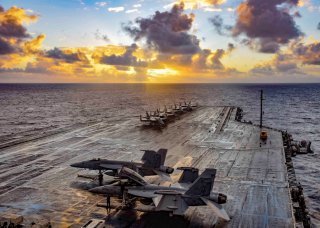Russia Is Jealous: Will Moscow Build Its Own Nuclear Aircraft Carriers?
Russia isn’t likely to acquire a new carrier, conventional or nuclear, any time soon. Carriers simply cost too much, and smaller helicopter carriers are a higher priority.
Here's What You Need to Remember: In the medium term, the Kremlin is focusing on buying two helicopter carriers. Each displacing just 15,000 tons of water, these smaller aviation ships could cost just a few billions dollars apiece and should be much easier to operate than a full-size flattop is.
Russia could build a new nuclear-powered aircraft carrier finally to replace its solitary, unreliable, and fire-damaged conventional flattop Admiral Kuznetsov.
Russia could do so, but it probably won’t. In fact, Russia isn’t likely to acquire a new carrier, conventional or nuclear, any time soon. Carriers simply cost too much, and smaller helicopter carriers are a higher priority.
Forbes commentator H.I. Sutton still believes, however. “Two competing designs, the Shtorm and the Lamantin, are in the frame to replace” Kuznetsov, Sutton wrote in mid-February 2020. “Both proposals have nuclear propulsion.”
The Nevskoye Design Bureau in St. Petersberg is behind the Lamantin proposal. A scale model of Lamantin was on display at a St. Petersburg military exhibition in 2019.
That design would displace around 90,000 tons of water, slightly less than what the U.S. Navy’s own 11 supercarriers displace, and would be able to embark as many as 60 aircraft, which is roughly double what Kuznetsov can handle.
The Shtorm, a somewhat larger design from the Krylov State Center, can embark up to 90 aircraft, making it roughly as capacious as an American carrier.
Russian president Vladimir Putin reportedly studied the new carrier designs in early January 2020. Back-to-back accidents involving Kuznetsov surely added urgency to Putin’s consideration.
The 35-year-old Kuznetsov in October 2018 suffered serious damage at the 82nd Repair Shipyard in Roslyakovo, a northern port city, when the PD-50 dry-dock sank while the carrier was aboard for repairs.
Swedish-built PD-50 was the only large dry-dock capable of supporting the Russian northern fleet’s largest warships. Russia's other large dry-docks are thousands of miles from the fleet's main northern bases.
Moving the docks, or the ships needing repair, could be prohibitively difficult, expensive, and time-consuming. Beside the cost, foreign sanctions complicate the acquisition of a dock similar to PD-50.
According to the newspaper Izvestia, the Kremlin considered just decommissioning Kuznetsov rather than spending the money to acquire a new dry-dock, move an existing dock or the carrier or find some other way of repairing the aging, unreliable and accident-prone flattop.
“Not everyone considers the continuation of repair to be appropriate,” a navy source reportedly told Izvestia. “There are different opinions, including those that boil down to the fact that with this money it is better to build a pair of frigates or a nuclear submarine.”
By spring 2019 a plan reportedly was in place to assemble a new dry-dock that in theory could accommodate the carrier. The No. 35 Ship Repair Plant in Murmansk in northern Russia has two, adjacent 600-feet-long drydocks that yard workers could combine in order to fit Kuznetsov.
Then on Dec. 12, 2019, disaster struck when diesel fuel ignited on one of Kuznetsov’s lower decks, Russian media reported. The carrier at the time was pier side in Murmansk for pre-planned repairs following the disastrous 2016 deployment to the Syrian coast.
The blaze spread to cover 6,500 square feet as firefighters struggled to contain it. One person died and 10 were injured in the fire, TASS reported. Six landed in intensive care.
Damage from the fire complicates the repair plan. Kremlin planners must weigh Kuznetsov’s value as a symbol of national prestige against her poor condition and the safety risk she poses to workers and crew.
Sutton’s optimism notwithstanding, the multi-billion-dollar cost of building a carrier -- to say nothing of the additional cost of the air wing and operations -- could give Putin and Kremlin officials pause.
The U.S. Navy spends around $13 billion building a new nuclear-powered flattop. Moscow spends just $70 billion annually on its entire armed forces.
Samuel Bendett, a researcher with the Center for Naval Analyses and a Russia studies fellow at the American Foreign Policy Council, told The National Interest the Kremlin eventually will fund a new carrier. “This is now a matter of national pride for Russia,” Bendett said.
“Wanting one and building one are two different things,” he said of carriers. “I think Russia will try to get as much mileage out of Kuznetsov before finally retiring it. But since Russia is aiming for a blue-water presence, having an aircraft carrier is a must.”
“On the other hand, there are significant costs associated with such a construction,” Bendett added, “which is why it’s taking Russia a while to organize its resources to settle on Kuznetsov's eventual replacement.”
In the medium term, the Kremlin is focusing on buying two helicopter carriers. Each displacing just 15,000 tons of water, these smaller aviation ships could cost just a few billions dollars apiece and should be much easier to operate than a full-size flattop is.
The two assault ships will be laid down at the Zaliv shipyard in Crimea in May 2020, two sources in Russia’s shipbuilding industry told TASS in late 2019.
David Axe is former Defense Editor of the National Interest. He is the author of the graphic novels War Fix, War Is Boring and Machete Squad.
This piece first appeared last year and is being reprinted due to reader interest.
Image: Flickr.

